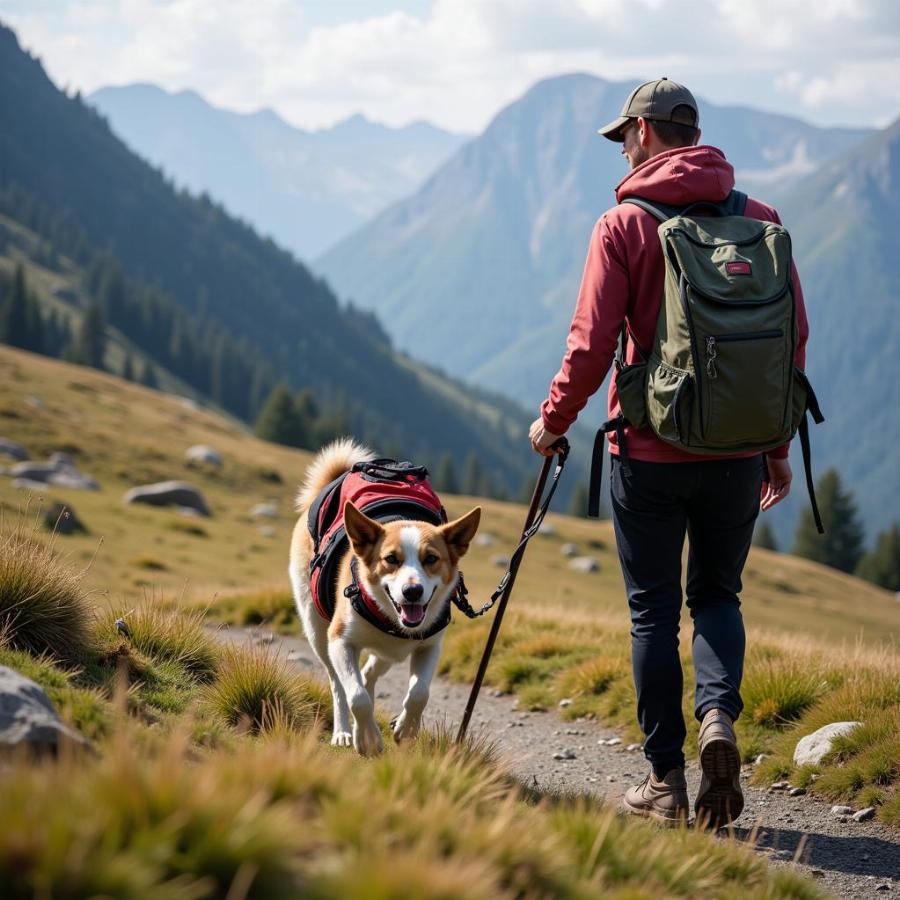High altitude (high alt) can pose unique challenges for dogs, just like it does for humans. Whether you’re planning a mountain vacation with your furry friend or live in a high-altitude area, understanding how these environments affect dogs is crucial for their well-being. This article will delve into the effects of high alt on dogs, covering symptoms, acclimatization, and essential tips for keeping your canine companion safe and comfortable at higher elevations.
Recognizing the Signs of High Alt Sickness in Dogs
Just like us, dogs can experience altitude sickness, also known as high-altitude illness. The decreased oxygen levels at high alt can lead to a variety of symptoms. Being aware of these signs is the first step in ensuring your dog’s safety. Some common symptoms include lethargy, loss of appetite, vomiting, difficulty breathing, and in severe cases, even collapse. If you notice any of these signs, it’s crucial to descend to a lower altitude immediately and consult a veterinarian.
Acclimatizing Your Dog to High Alt
Gradual acclimatization is key to minimizing the risk of high alt sickness in dogs. Just as hikers gradually ascend to higher altitudes, allowing your dog’s body time to adjust is essential. Start with shorter walks and gradually increase the duration and intensity of exercise as your dog acclimates. Always monitor your dog closely for any signs of distress. Remember, patience and careful observation are crucial during this process.
Essential Tips for Dogs at High Alt
Taking a few precautions can significantly improve your dog’s experience at high alt. Always carry plenty of fresh water and encourage your dog to drink regularly to stay hydrated. Avoid strenuous exercise during the initial days at a higher elevation. Provide a comfortable resting place for your dog, and consider using a dog carrier or backpack for smaller breeds during challenging hikes.
 Chó leo núi cùng chủ nhân
Chó leo núi cùng chủ nhân
What are the Common Signs of High Altitude Sickness in Dogs?
The most common signs include lethargy, loss of appetite, vomiting, and increased respiratory rate. In severe cases, dogs may experience difficulty breathing, incoordination, and even collapse.
How Can I Help My Dog Acclimatize to High Altitude?
Gradual acclimatization is essential. Start with shorter walks and progressively increase the duration and intensity of activity as your dog adjusts.
Is it Safe to Take My Dog to High Altitude?
With proper precautions and acclimatization, most dogs can safely enjoy high-altitude environments. However, it’s crucial to monitor your dog closely and consult a veterinarian if you notice any signs of altitude sickness.
Conclusion
High alt adventures can be enjoyable for both you and your canine companion. By understanding the potential risks and taking appropriate precautions, you can ensure a safe and memorable experience. Remember to monitor your dog closely for signs of high alt sickness, prioritize gradual acclimatization, and always consult a veterinarian if you have any concerns. Enjoy the majestic mountains with your furry friend!
FAQs
- What is high alt sickness in dogs? High alt sickness, or high-altitude illness, occurs when a dog’s body struggles to adjust to the lower oxygen levels at higher elevations.
- How can I prevent high alt sickness in my dog? Gradual acclimatization is the most effective way to prevent high alt sickness.
- What should I do if my dog shows signs of high alt sickness? If your dog exhibits any symptoms, descend to a lower altitude immediately and seek veterinary care.
- Can all dogs go to high altitudes? Most dogs can tolerate high altitudes, but some breeds, particularly those with brachycephalic (short-nosed) features, may be more susceptible to altitude sickness.
- What are the long-term effects of high alt on dogs? While temporary exposure to high alt is generally safe, prolonged exposure can lead to more serious health complications in some dogs.
Further Reading
You might also be interested in reading about dogs alp high or allergy testing for dogs cost. For information on dog training, check out electric collar for big dogs. Lastly, for a cautionary tale, read about lady mauled by dogs. And for dietary information, consider can dogs eat korean pears.
Beaut Dogs: Your Trusted Source for Canine Care
Beaut Dogs is your one-stop resource for all things related to dog care, offering expert advice on everything from breed selection to health and nutrition. We provide in-depth guides and helpful tips to ensure your canine companion thrives. When you need support, don’t hesitate to contact us at [email protected] (Email address) for detailed and accurate information from Beaut Dogs. We’re here to help you navigate the wonderful world of dog ownership.